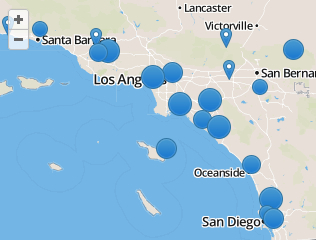Location, location, location.
The concept immediately brings back to mind college marketing classes and textbooks; clear lessons from industrial age distribution models. The focus has slowly faded away, however, over the past couple of decades with the invention and growth of a digitally connected, flat economy in which we can buy anything… from anyone… from anywhere.
Except… for most of us, where we are is actually a huge driver of what we do. Mitch Lieberman, has recently been placing more emphasis on context. For a few years now, I’ve heard and seen statements floating by my activity streams like “Content is king, but context is queen”. Robert Scoble and Shel Israel are in the process of writing about the “Age of Context”.
They’ve all picked up on the fact that we’re moving from an era of BIG, CRUDE, AND MANUAL TO SMALL, MEASURED, AND AUTOMATIC.
All of us, in our personal and professional lives, are desiring requiring more relevance, more alignment, and more accurate filters to help us navigate the bombardment of information we encounter in our daily lives.
Relevance. Context. All of a sudden, location matters again. Though, it’s contribution to customer behavior is manifesting itself in a different manner.
Even with the dramatic rise of e-commerce, most consumers still purchase from brick and mortar stores. According to a 2012 study:
Though consumers are using their mobile devices more than ever to find deals and research products, they still love their brick-and-mortar stores, a new study shows. Despite the proliferation of devices, shopping applications and growing consumer comfort with the mobile channel, the vast majority (90 percent) of both online and offline shoppers involve a store visit in many of their purchases.
Until recently, e-commerce and brick and mortar business models have been largely detached. Even for many major retailers, stock, pricing, returns were not connected. That era is giving way to a connected experience where consumers interact with brands across channels (brick and mortar, 3rd party retail, e-commerce, social), with the increased expectation of a unified experience across them all.
If I’m at the beach, please don’t send me an offer about printer cartridges. If I’m out to dinner, an offer about a local gelateria is much more likely to get opened than an email about gardening services.
A growing sea of online technology companies allow our location patterns and habits to be tracked (and hopefully used for mutually beneficial purposes).
Companies like Facebook, Foursquare, and Yelp allow users to check in, sharing with their network where they are. At the same time, they’re also sharing their information with a growing cadre of location based advertisers. By knowing which areas consumers frequent, more relevant ads can arguably be served. In addition to understanding the sum total of checkins and locations, patterns can be detected, and psychographic, sociographic, and demographic profiles can arguably be constructed to recommend offers that are relevant based on previous behavior.
Some consumers can’t be bothered with checking in, however. It takes time, effort, and giving away information to “big brother in the sky” isn’t all that appealing to most people, especially when there’s limited value in return.
Other emerging startups like PlaceMe, Banjo, Sonar, Friday, and Highlight automatically tracks your whereabouts and the whereabouts of others near you, offering serendipitous and/or more targeted “people discovery” opportunities.
But, without opting in or participating in any of the above, those little smartphones in our pockets are already tracking and providing plenty of information to the mobile platform vendors and application providers.
This controversial 2010 Wall Street Journal article highlighting an interview with Google’s Eric Schmidt provides clues related to role location plays in the future of context, commerce, and marketing.
“I actually think most people don’t want Google to answer their questions,” he elaborates. “They want Google to tell them what they should be doing next.”
Let’s say you’re walking down the street. Because of the info Google has collected about you, “we know roughly who you are, roughly what you care about, roughly who your friends are.” Google also knows, to within a foot, where you are. Mr. Schmidt leaves it to a listener to imagine the possibilities: If you need milk and there’s a place nearby to get milk, Google will remind you to get milk. It will tell you a store ahead has a collection of horse-racing posters, that a 19th-century murder you’ve been reading about took place on the next block.
Merging location data with transaction data
Until now, the emerging benefit and value of location data has struggled to find it’s legs in a meaningful way. However, when I was offered a discount on a purchase from American Express last year if I connected my AMEX account to my foursquare account, I immediately saw the benefit for AMEX. They already know what I spend money on. If they also know where I go, they can find all sorts of things out about me.
- What % of my spending do I put on my AMEX card?
- By merging transaction, demographic, and geogrpahic behavior patterns, they can begin to construct a psycho-graphic and/or deeper socio-graphic profile of me
- By understanding who I am connected to and/or communicating with, they can potentially begin to understand purchasing behaviors within my network
- Finally: the unknown. Like many emerging big data initiatives, finding unforeseen patterns in data models can provide new unforeseen opportunities.
Even without real time location data, merging data collected from the digital realm with other data sets presents new opportunities for contextual marketing. From AllThingsD:
Ticketmaster is doing all the normal stuff you’d expect to help users share with each other when they buy tickets to events. But it’s also the only partner that I saw mashing up multiple Open Graph applications.
If you listen to music on an Open Graph application like Spotify, Ticketmaster automatically detects (with your permission) and tells you when those artists are next playing in your town. Usually these apps depend on which artists you “Like” or explicitly follow. It seems smart to use real, dynamic listening data to figure this out.
VinTank is working on a technology that indexes preferences and buying behavior of premium wine lovers, sends alerts to wineries in Napa Valley when a potential fit for their products are nearby, allowing them to send a message or offer that should offer high appeal for that person.
However, Jack Dorsey’s Square, which is in the process of disrupting the world’s commerce payment systems, is approaching location based marketing from the opposite end of the spectrum, and thinks they’ll actually be able to make location more useful. While many first generation location apps vendors know where you are and perhaps what you’ve done, they typically don’t have any data on what you purchased. It’s the merging of location, transaction, and social data that some might describe as the next holy grail. Creating a recommendation engine based on financial transactions, and using location as a contextual filter for commercial transactions holds significant promise.
Deeper customer understanding at the center
At the center of customer focused innovation is understanding your customers better.Understanding where people go, and what they buy when they’re there will be a significant input for next generation commerce.
The data being collected by the payment gateways (Mastercard, Visa, American Express, Square, PayPal, GoPayment) is arguably more valuable than the transaction fees they are collecting. More intelligence is being built in to the purchase and sales cycles, respectively, and at the center of both sides are recommendation engines. Consumers are coming to expect Amazon.com-like suggestions that make their life easier and shorten the investment of discovery and analysis.
Understanding transactional and behavioral patterns and merging them together will arguably allow marketers to offer more precise offers and interactions based on a deeper understanding of their customer’s current context.
- How is your organization leveraging location data?
- What are the primary barriers you see?
- How will privacy issues come in to play as technology advances?
| This post was written as part of the IBM for Midsize Business program, which provides midsize businesses with the tools, expertise and solutions they need to become engines of a smarter planet. I’ve been compensated to contribute to this program, but the opinions expressed in this post are my own and don’t necessarily represent IBM’s positions, strategies or opinions. |




